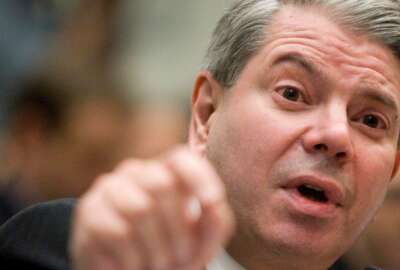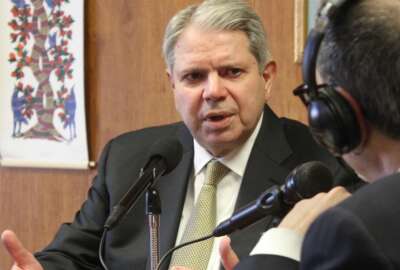

Throughout the pandemic, citizens might have suspected that components of the Health and Human Services Department weren't quite coordinated. Now the Government...
Throughout the pandemic, citizens might have suspected that components of the Health and Human Services Department weren’t quite coordinated. Now the Government Accountability Office has put HHS leadership and coordination of public health emergencies on the list of at-risk federal programs. To find out why, Federal Drive with Tom Temin spoke with Mary Denigan-Macauley, GAO’s Director of Health Care Issues.
Interview transcript:
Tom Temin All right. So why did HHS’ coordination and leadership here in public health emergencies make the high risk list?
Mary Denigan-Macauley Yeah, well, it’s not something that we take lightly, and it certainly isn’t something that just came about in light of the pandemic. We looked at over a decade worth of work and we really have seen some persistent deficiencies in HHS’ ability to perform its role, leading the nation’s preparedness for response to and recovery from a pandemic.
Tom Temin HHS is a department, but it’s many components, and you’ve got a lot of subcomponents that impinge on this. [Centers for Disease Control and Prevention (CDC)], for one, different pieces of [National Institutes of Health (NIH)] as we learned in the pandemic, the infectious disease group. And then there’s [Food and Drug Administration (FDA)] has a role. Is this what you’re talking about? Is it the coordination and the story getting out in some cogent fashion of what’s going on within HHS? Or does it also involve other departments?
Mary Denigan-Macauley Well, for the high risk designation, we are talking about HHS and those components that you spoke with. In particular, ASPR, which is now known as the Administration for Strategic Preparedness and Response, has that lead medical and preparedness and response and recovery role that it needs to carry out. But it doesn’t do this alone, public health isn’t done just at the federal level. It takes a whole of government approach. And so they have to work with their key stakeholders, including other federal agencies, as well as state, local, tribal and territorial partners. It’s a pretty big endeavor that they have to do.
Tom Temin And what happened specifically during the COVID pandemic that gave rise or that showed in relief what their issues are, with respect to leadership and coordination?
Mary Denigan-Macauley Well, unfortunately, we found quite a few different areas, and we’re able to lump them into a few buckets. So if you take one of our first buckets is really looking at roles and responsibilities. You can’t have confusion during the middle of a crisis. You have to be able to act immediately, because every second counts. And you’re not just talking about a hypothetical here, You’re talking about lives. You’re talking about work. You’re talking about children being able to be in school when you’re looking at a pandemic. It affected absolutely every aspect of our life. So being able to understand the roles and responsibilities, and not bickering over them and trying to figure out who’s in charge is really critical. And one particular area that we saw that happened with was the repatriation. Bringing our Americans home that were over in China or stuck on cruise ships is a great example where there was no clear leadership, and CDC was looking at ASPR, and ASPR was looking at CDC and pointing like who has responsibilities that really puts not only the responders at risk, but then the community. I mean, some people that should have been quarantined started to walk out into the community.
Mary Denigan-Macauley So in addition to roles and responsibilities, you also need complete and consistent data. If you look at how our data is collected, it’s very disparate. It takes all of those layers of the U.S. government and it needs to be rolled up to get a national picture, and we just don’t have that capability right now. So that’s another area, and communication. We all saw the communication problems that were occurring. Wear a mask, don’t wear a mask. Make sure that you get the vaccine, don’t worry you are going to be 100% protected. Well, it’s not really 100% protection, it stops you from going into the hospital. So you have to have clear communication in order to build trust. Transparency and accountability. If you look at the arguments that are going on or just the origins of the COVID, and is there enough oversight of this risky type of research and being transparent about that oversight instead of keeping it in a black box, absolutely paramount. And then last but not least, understanding your key partners capabilities and limitations. Making sure that you know, for example, if the Department of Defense is going to come and help, what resources are they going to bring? During the hurricanes, Irma and Maria, we saw this is really a problem. They bought resources that HHS didn’t need at that particular time. So that’s key too, understanding your partners capabilities.
Tom Temin We’re speaking with Mary Denigan-Macauley. She’s director of health care issues at the Government Accountability Office. And what about the idea of doctrine? If you look at the Defense Department, they have detailed plans and detailed operational, well, it’s called doctrine for if this happens, here’s what we do and here’s who does it. I’ve read over the years, as far back as the George W. Bush administration, there was a substantial, I guess the word nowadays they use as playbook, for what happens in a pandemic. And nobody could find that book or nobody paid any attention to it. It seems like that’s a missing element also, is a master plan.
Mary Denigan-Macauley Yeah. So, Tom, I’m laughing because it’s the big question. What happened to the plans? Why didn’t we follow the plans? Because we certainly have a lot of plans. And I’ve been at GAO long enough to have looked at those plans. We started those plans when we saw bird flu coming about and worried that that was going to become a human pandemic. And plans are only as good as they are tested. And the testing then reveals gaps and you have to close the gap, so that’s first and foremost. But also, plans are full of assumptions. And one of the assumptions was that it was going to be an influenza, that you would have test kits available and ready to go for an influenza pandemic. This was not an influenza pandemic. And so our hope is that HHS, and we’re going to continue to follow up on this, is look at some of the assumptions and look at the testing and look at the exercising and how they’re going to revise those plans so that we’re better prepared for next time and fill those gaps.
Tom Temin And I guess, GAO can’t address this directly. But it seems that when there is this vacuum of leadership coordination and nobody knows who’s supposed to do what, that leaves a lot of running room for politicians to come in and weigh in. And we saw that a lot during the pandemic, too. Is that part of the report or is that kind of just implied to the people you deliver the report to?
Mary Denigan-Macauley I think that if you look at communication and you look at leadership commitment, those two come hand in hand with the work that we’ve done. You do need clear communication. You certainly don’t want an administration or a head of an agency saying something different than another head of an agency. And so that’s all part of what we feel is needed going forward, is to make sure that you do have consistent communication that is clear. And you don’t have mixed signals, because the public is not going to trust the science, they’re not going to trust the politicians if there’s mixed signals.
Tom Temin Right. Because large public health emergencies brew that kind of conflict that is always inherent in some of these things, and that is liberty versus individual choice versus what you need to do, because you are part of a community. And there’s no single dead right answer on that. But those are the kind of issues that get swirled up when these happen.
Mary Denigan-Macauley That’s right, absolutely. And it’s particularly challenging, too, because we’re not like some countries where you can just say, this is what we’re going to do. We’re going to lockdown. You’re not going to be able to move. We have states, they have independent rights. And so that communication becomes even more important when you have a constitutional set up like we have here in the United States.
Tom Temin All right, then, what’s the prescription here? How did HHS take the report, being on the high risk list and the documentation of that? And what is your best recommendations for them to get off the list?
Mary Denigan-Macauley Well, it certainly is not going to happen overnight. And I think HHS recognizes that. First and foremost, you don’t have just one agency within HHS that needs to resolve this problem. And the agencies have taken this very seriously. You may have heard that ASPR is undergoing a realignment where they want to become a standalone agency to be able to be more nimble and to be able to respond more effectively. We’re watching that transformation there. CDC has also said that they’re going to undergo some reform, as is FDA. So we’re watching all of these reform efforts very carefully. And as a part of reform effort, you also need to make sure that you have the workforce, and that’s what we call building the capacity to make sure you have the right experts with the right understanding resources at your helm to be able to implement the changes that you want to do as well. And of course, you have to have a leadership commitment. Without leadership commitment, it’s all for naught. And we need to have sustained attention, because as we’ve seen with changes in administration, come changes with the plans that are put on paper. And so really we need sustained attention, which is what we’re hoping that this will bring. Finally, we need to have action plans. And while there are some broad plans out there, we need real root cause action plans to be able to get at solutions and milestones and the resources that are needed. And then, of course, very GAO-ish, you have to monitor it and you have to track your progress.
Copyright © 2024 Federal News Network. All rights reserved. This website is not intended for users located within the European Economic Area.
Tom Temin is host of the Federal Drive and has been providing insight on federal technology and management issues for more than 30 years.
Follow @tteminWFED



